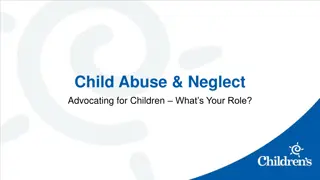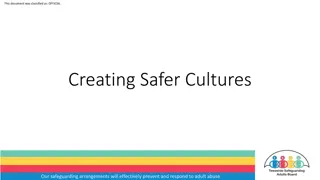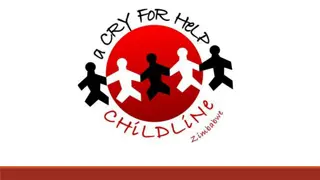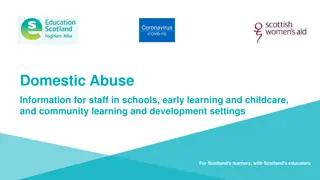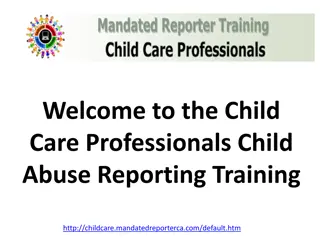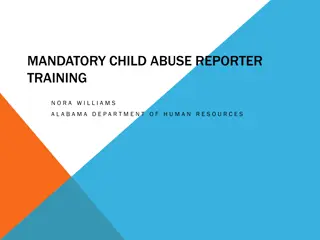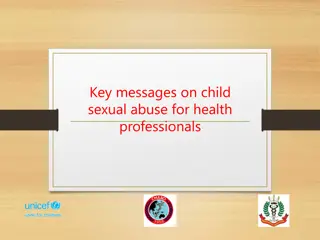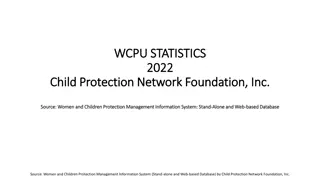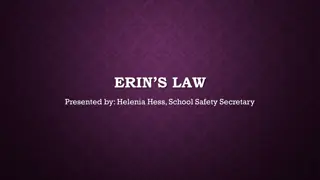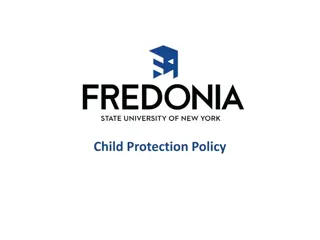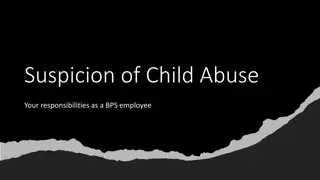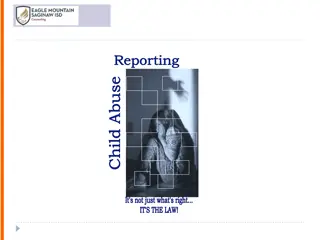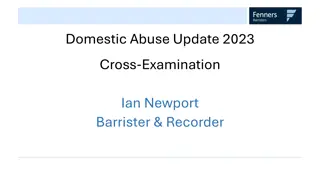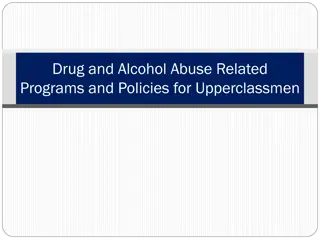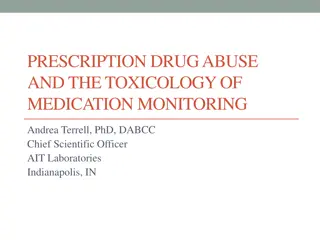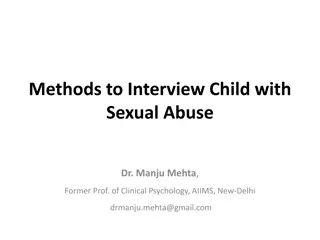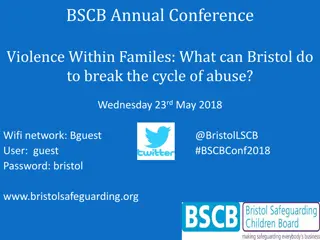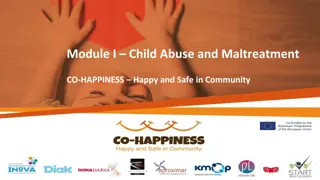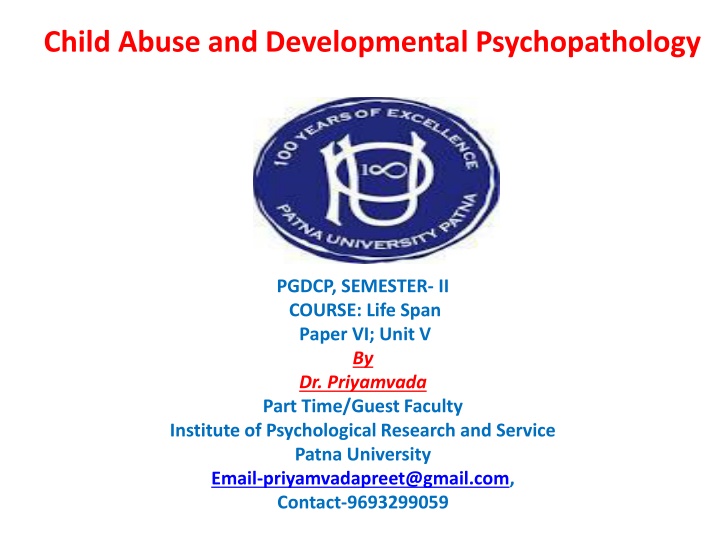
Child Abuse and Developmental Psychopathology
Explore the impact of child abuse on developmental psychopathology, with insights on the abusive parent-child dynamic and long-term effects on the child's development. Consider the complexities in detecting and addressing abuse-related issues.
Download Presentation

Please find below an Image/Link to download the presentation.
The content on the website is provided AS IS for your information and personal use only. It may not be sold, licensed, or shared on other websites without obtaining consent from the author. If you encounter any issues during the download, it is possible that the publisher has removed the file from their server.
You are allowed to download the files provided on this website for personal or commercial use, subject to the condition that they are used lawfully. All files are the property of their respective owners.
The content on the website is provided AS IS for your information and personal use only. It may not be sold, licensed, or shared on other websites without obtaining consent from the author.
E N D
Presentation Transcript
Child Abuse and Developmental Psychopathology PGDCP, SEMESTER- II COURSE: Life Span Paper VI; Unit V By Dr. Priyamvada Part Time/Guest Faculty Institute of Psychological Research and Service Patna University Email-priyamvadapreet@gmail.com, Contact-9693299059
Child Abuse and Developmental Psychopathology An understanding of the abused child has direct relevance for improving our understanding of the abusive parent. This is because the abused child who experiences psychological problems during early childhood as a result of maltreatment may suffer long-term, developmental impairments or maladaptation that persist into adulthood. These impairments, in turn, contribute toward the regeneration of the abusive cycle. The dimensions of self-control,closeness, and attachment to others, peer relationships, and social competence are common themes that emerge in studies of abused children and reemerge in studies of abusive adults.
Conted it is necessary to look first at the accuracy of our preconceptions of how abuse affects the child in the short and long term. Similar to other forms of adversity and trauma during childhood (e.g., parental death or divorce), child abuse does not affect each victim in a predictable or consistent fashion. Moreover, the impact of abuse cannot always be detected in terms of its negative or undesirable influences upon the child's development, especially when positive mediators of adjustment (e.g., supportive relatives, early cessation of abuse, child's coping strengths) are taken into consideration.
Conted Findings pointing to the negative impact of abuse on the child's development may be the result of more systemic influences that often accompany the presence of physical abuse. These influences include the more dramatic events, such as marital violence and separation of family members, as well as the more mundane, yet significant, everyday child-rearing activities that may be disturbing or maladaptive, such as low rates of interaction, few teaching opportunities, and socioeconomic disadvantage. child abuse is often accompanied by family instability, parental inadequacy or ineffectiveness, and socioeconomic disadvantage, it is difficult, if not impossible, to partial out the unique impact that physical abuse has on child development . These cautionary issues not with standing, there is a consensus in the literature that abused children display a significantly greater number or developmental difficulties than non abused children (delinquency, school problems, speech and language delays, peer problems).
Developmental Psychopathology Because abusive family environments are often characterized by physical and emotional rejection, harsh treatment, insensitivity, and verbal assaults. The security or quality of the early relationship formation between the parent and the child, for example, has been linked to the child's emerging mastery of the social and physical environment. Secure attachment fosters a high level of capabilities, goals, and actions throughout the child's development and therefore any disruption in this maturational process could have significant effects on the child's intellectual and social interactional skills. The studies indicates that child abuse during infancy and early childhood is associated with insecure attachment relationships with the caregiver. In particular, abused infants have been found to cling to their mothers and/or display negative affect toward their caregivers significantly more often than non abused controls. Disturbances in Child Temperament and Relationship Development
conted Furthermore, findings from prospective studies have linked early attachment problems to patterns of declining developmental abilities over the first two years of life (e.g., speech and language, social interaction. The importance of the early parent-child relationship is thus underscored by these findings, especially in reference to the possible beginnings of parent-child conflict, parental non responsiveness to infant demands, parental failure to provide stimulation and comfort to the infant, and infant characteristics that interact with parental ability. Problems associated with the development of a poor or maladaptive attachment relationship are believed to be the result of an interactional process involving both the parent and the child, which has led to concern about the child's provocative role in abuse.
Conted Some children, due to suspected differences in temperament or regularity, may be more difficult to care for and console than others. These temperamental differences include, for example, reactivity to stimuli, emotional lability, and sleeping or eating irregularity. Such children, it is argued, provide more opportunities for the parent to become irritated and frustrated, because parental attempts to elicit positive responses from the child may seldom be rewarded. In accordance with conditioning principles, particular child features, such as crying or fussing, may become associated with the parent's negative emotion, so that the child's behavior and/or features elicit conditioned parental responses of anger, irritation, and/or aggression.
Conted the parent and child each prefer different modes of interaction and consequently fail to reinforce one another. For example, the child may resist physical contact (e.g., hugging, embracing, or touching), whereas the parent may prefer highly tactile interactions. If the parent perceives the child's behavior as rejection or annoyance, he or she may begin to experience anger and negative emotions that serve to mediate aggressive behavior.
2. Disturbances in Cognitive and Interpersonal Development In addition to the risk of physical harm stemming from abuse are concerns about the possible long-range impairments to the child's cognitive, emotional, and behavioral development. The findings of several studies, indicating that abused children are more likely than their peers to show developmental delays, especially in language acquisition and the ability to discriminate emotions in others. Abused preschool-age children showed an average difference of 20 IQ points in comparison to a matched sample of non-abused children and their ability to judge allocation of resources, seriousness of punishment, and fairness of rules was found to be significantly below that of their peers.
Conted Similar developmental delays or deficiencies have been found among older abused children. The endemic social and family factors present in abusive families may be responsible for the risk of impairment across all children in the family. Studies of abused children's social behavior with peers and adults have also found that they display more aggression toward peers, poor self-control and attentional ability and low enthusiasm and greater verbal and physical resistance to directions. The teacher reports of the child's social immaturity and poor readiness to learn during the preschool years. The school-age abused child, moreover, is often perceived by parents and teachers as more difficult to manage, less socially mature, and less capable of developing trust with others. Finding suggest that they exhibit higher rates of aggressive and aversive behavior (e.g., yelling, hitting, destructiveness) when interacting with their caregivers.
Implications for Treatment and Prevention of Child Abuse 1. Coping with Stressful Child-rearing Situations Aggression toward a child can be prevented if the parent copes with the situation, especially once he or she begins to feel angry and out of control. Coping is defined as the "behavioral and cognitive effort to master, tolerate, or reduce the internal and/or external demands that are created by a stressful transaction" (Folkman, 1984). According to this formulation, coping efforts serve two main functions: the regulation of emotional distress or negative arousal (emotion-focused coping) and the management or alteration of the person-environment relationship (problem-focused coping). Both emotion- focused and problem-focused coping skills are used in most stressful situations (Folkman & Lazarus,1980).
Conted child abuse can be viewed as a form of maladaptive coping in response to perceived stressful encounters with a child. It is argued that these transactions are appraised by the parent as being uncontrollable due to perceived provocation by the child and inadequate or unavailable resources upon which to rely for managing the situation. A heightened emotional state arises, which impairs rational problem solving. The parent is unable to generate solutions, and his or her behavior becomes more impulsive, relying on one or several of a number of learning experiences (ineffective modeling by the parent's own mother or father, socially endorsed actions by deficient support systems, negative reinforcement for using physical punishment). According to Lazarus and his colleagues, when negative emotions (anger, anxiety, frustration) are reduced or aspects of the situation are changed (by changing the other person's behavior or the individual s own behavior through problem solving, direct action, decision making), the perceived meaning of the situation is altered, which leads to a greater perception of control over the distress. Folkman and Lazarus (1980) reasoned that problem-focused coping depends largely on the success of emotion-focused coping. If the attempts to reduce the negative emotion fail, the heightened arousal interferes with the cognitive functioning necessary for problem solving. Thus, to gain control over the parent child interaction, the stressed parent can reduce the feelings of frustration and anger, change the child's behavior, or change his or her own disciplinary tactics.
2. Treatment Modalities with Abusive Families From the above discussion, it is clear that prevention programs for high-risk parents or treatment strategies for abusive parents must take a multifaceted approach. According to Kelly, 1983 the number of treatment areas is potentially overwhelming, including - child management skills attitudes and knowledge about child rearing positive role models for appropriate parenting social support stress management for both intra familial and extra familial events coping and life skills training The major criteria for successful treatment outcome, regardless of treatment modality, can be summarized as: (1) Increasing the parent's ability to inhibit aggressive responding toward the child and facilitate positive child development (2) Developing general coping skills and positive relationships to reduce the impact of aversive events that can interfere with the effectiveness of the parent-child relationship (Conger & Lahey, 1982)
Treatment Modalities with Abusive Families- 1.Positive Child Management Techniques Effective training of parenting skills involves not only the reduction of harsh, extra punitive child-rearing methods but also learning how to attend to the child and to stimulate his or her pro social development. As in other behavioral parent- training programs aimed at families with child behavior problems (e.g., Forehand & McMahon, 1981), parents are taught how to discourage noncompliant behavior by such means as time out, ignoring inappropriate behavior, and using effective commands (e.g., facilitating compliance by pointing to objects, specific wording, short sentences). In addition, they are taught to encourage compliant and pro- social behavior by using appropriate directives and rewards (e.g., naming the specific behavior for which the child is being reinforced) and to provide positive interaction time with the child. A major training emphasis with abusive parents has been on modeling of appropriate positive and disciplinary parenting techniques by the therapist and rehearsal of the skills with the parent's own child. This involves a "hands-on" skills-training approach that tailors the individual therapeutic program to the specific needs of the parent and child. It builds upon the strengths of the parent (e.g., firm voice, use of physical positives), while modifying ineffective or inappropriate methods of controlling the child's behavior. This approach offers direct assistance to the parent in the most difficult areas and relies less on didactic instruction or insight
Treatment Modalities with Abusive Families- 2.Training in the Reduction of Stress, Anger, and Arousal Abusive parents tend to view their environment and the parenting role as more stressful and experience more concomitant physical and emotional distress than non maltreating parents. This heightened anxiety, accompanied by negative emotions and reduced physical stamina, probably impedes the parent's effectiveness in managing his or her child (Wolfe, 1985a). Thus, the elimination or reduction of perceived areas of stress involving both child rearing and other interactions will probably benefit the parent's child-rearing skills. This has been approached through techniques that help to modify the parent's perception that the child is a provocation (Bauer & Twentyman, 1985) and their reduced sense of control in the parenting role and related situations (LaRose, Wolfe, & Mattaroccia, 1986). One approach that has shown success with a wide range of behavior problems (e.g., phobias, anger control) is the stress inoculation procedure developed by Meichenbaum (Meichenbaum & Cameron, 1983). The general procedure is to teach the individual the role that cognitions and emotions play in engendering stress, train him or her in the fundamentals of self- monitoring and problem solving, model and rehearse problem solving and emotion reduction, and assign graded in vivo behavioral tasks. This procedure has been used with abusive parents to teach them to relabel their emotions from extreme anger, for example, to a milder form of irritation (Denicola & Sandler, 1980; Nomellini & Katz, 1983).
Conted This process can be taught to parents while they are interacting with their children in realistic circumstances that might lead to feelings of frustration and anger (e.g., putting away toys). To reduce further the parents' physiological and cognitive arousal and to improve their sense of mastery over strong negative emotions (e.g., the sense of losing control), imaginal systematic desensitization in conjunction with relaxation training may be taught, followed by in vivo rehearsal with the child under therapist supervision (Koverola, Elliot-Faust, & Wolfe, 1984; Wolfe, Sandler, & Kaufman, 1981). The above procedures have several elements in common: (1) reducing the impact of negative arousal and stressful interpretations that sometimes result in maladaptive behavior and (2) training aimed at reducing skills deficits associated with the parenting role, with the goal of acquiring greater feelings of control during stressful situations. In addition to these goals, treatment approaches must be sensitive to factors coexisting with this problem that extend beyond contemporaneous events (Wahler & Graves, 1983).
Furthermore, other deficits in social skills, financial planning, or job skills may serve to increase the frustration level of parents, decreasing the level of tolerance that they might have for noncompliant child behavior (Kelly, 1983; Wolfe, 1985a). It appears essential, then, that such factors be addressed to some degree in any preventative or remedial program
References: World report on violence and health; child abuse and neglect by parents and other caregivers. Hetherington and Parke(1999); Child Psychology. Benjamin. B. Lahey., and Alan. E. Kazdin ; Advances in clinical child psychology, plenum press, Vol-10, ISSN 0149-4732, Google images and Google search. Thank you

